Decadal Modulation of Summertime Northwestern Pacific Subtropical High Linked to Indian Ocean Basin Warming
Abstract
1. Introduction
2. Materials and Methods
3. Results
3.1. Atmospheric Responses to Climatological SST States
3.2. Combined Effects of IOBW Anomalies and Accompanying Tropical SST Anomalies
3.3. Influential Contributors to Differences Between Period 1 and Period 2
4. Conclusions
Author Contributions
Funding
Data Availability Statement
Acknowledgments
Conflicts of Interest
Abbreviations
| SST | Sea surface temperature |
| NPSH | Northwestern Pacific Subtropical High |
| CP-ENSO | Central Pacific El Niño–Southern Oscillation |
| IOBW | Indian Ocean basin warming |
| IPOC | Indo-western Pacific Ocean Capacitor |
| EP-ENSO | Eastern Pacific El Niño–Southern Oscillation |
| IPO | Interdecadal Pacific Oscillation |
| CMIP5 | Coupled Model Intercomparison Project phase 5 |
| AFES | Atmospheric Model for the Earth Simulator |
| JRA-3Q | Japanese Reanalysis for Three Quarters of a Century |
| CMIP6 | Coupled Model Intercomparison Project phase 6 |
References
- Kawase, H.; Imada, Y.; Sasaki, H.; Nakaegawa, T.; Murata, A.; Nosaka, M.; Takayabu, I. Contribution of historical global warming to local-scale heavy precipitation in western Japan estimated by large ensemble high-resolution simulations. J. Geophys. Res. 2019, 124, 6093–6103. [Google Scholar] [CrossRef]
- Imada, Y.; Kawase, H. Potential seasonal predictability of the risk of local rainfall extremes estimated using high-resolution large ensemble simulations. Geophys. Res. Lett. 2021, 48, e2021GL096236. [Google Scholar] [CrossRef]
- Ashok, K.; Behera, S.K.; Rao, S.A.; Weng, H.; Yamagata, T. El Niño Modoki and its possible teleconnection. J. Geophys. Res. 2007, 112, C11007. [Google Scholar] [CrossRef]
- Kug, J.-S.; Jin, F.-F.; An, S.-I. Two types of El Niño events: Cold tongue El Niño and warm pool El Niño. J. Clim. 2009, 22, 1499–1515. [Google Scholar] [CrossRef]
- Song, J.; Klotzbach, P.J.; Duan, Y. Differences in western north Pacific tropical cyclone activity among three El Niño phases. J. Clim. 2020, 33, 7983–8002. [Google Scholar] [CrossRef]
- Xie, S.-P.; Hu, K.; Hafner, J.; Tokinaga, H.; Du, Y.; Huang, G.; Sampe, T. Indian Ocean capacitor effect on Indo-western Pacific climate during the summer following El Niño. J. Clim. 2009, 22, 730–747. [Google Scholar] [CrossRef]
- Xie, S.-P.; Kosaka, Y.; Du, Y.; Hu, K.; Chowdary, J.S.; Huang, G. Indo-western Pacific ocean capacitor and coherent climate anomalies in post-ENSO summer: A review. Adv. Atmos. Sci. 2016, 33, 411–432. [Google Scholar] [CrossRef]
- Mochizuki, T. Interannual Fluctuations and Their Low-Frequency Modulation of Summertime Heavy Daily Rainfall Potential in Western Japan. Atmosphere 2024, 15, 814. [Google Scholar] [CrossRef]
- Stuecker, M.F.; Jin, F.-F.; Timmermann, A.; McGregor, S. Combination mode dynamics of the anomalous Northwest Pacific anticyclone. J. Clim. 2015, 28, 1093–1111. [Google Scholar] [CrossRef]
- Zhang, W.; Jin, F.-F.; Stuecker, M.F.; Wittenberg, A.T.; Timmermann, A.; Ren, H.-L.; Kug, J.-S.; Cai, W.; Cane, M. Unraveling El Niño’s impact on the East Asian Monsoon and Yangtze River summer flooding. Geophys. Res. Lett. 2016, 43, 11375–11382. [Google Scholar] [CrossRef]
- Nitta, T. Global features of the Pacific-Japan oscillation. Meteor. Atmos. Phys. 1989, 41, 5–12. [Google Scholar] [CrossRef]
- Xie, M.; Wang, C.; Chen, S. The role of the maritime continent SST anomalies in maintaining the Pacific–Japan pattern on decadal time scales. J. Clim. 2022, 35, 1079–1095. [Google Scholar] [CrossRef]
- Yim, S.-Y.; Hjun, J.-G.; Yeh, S.-W. Decadal change in the relationship between east Asian–western North Pacific summer monsoons and ENSO in the mid-1990s. Geophys. Res. Lett. 2008, 35, L20711. [Google Scholar] [CrossRef]
- Park, J.-Y.; Jhun, J.-G.; Yim, S.-Y.; Kim, W.-M. Decadal changes in two types of the western North Pacific subtropical high in boreal summer associated with Asian summer monsoon/El Niño–Southern Oscillation connections. J. Geophys. Res. 2010, 115, D21129. [Google Scholar] [CrossRef]
- Chen, X.; Zhou, T. Relative role of tropical SST forcing in the 1990s periodicity change of the Pacific-Japan pattern interannual variability. J. Geophys. Atmos. 2014, 119, 13043–13066. [Google Scholar] [CrossRef]
- Sui, C.-H.; Chung, P.-H.; Li, T. Interannual and interdecadal variability of the summertime western North Pacific subtropical high. Geophys. Res. Lett. 2007, 34, L11701. [Google Scholar] [CrossRef]
- Zhao, H.; Wang, C. On the relationship between ENSO and tropical cyclones in the western North Pacific during the boreal summer. Clim. Dyn. 2019, 52, 275–288. [Google Scholar] [CrossRef]
- Mochizuki, T.; Watanabe, M. Observed and hindcasted subdecadal variability of the tropical Pacific climate. ICES J. Marine Sci. 2019, 76, 1271–1279. [Google Scholar] [CrossRef]
- Mochizuki, T.; Watanabe, M. Atlantic impacts on subdecadal warming over the tropical Pacific in the 2000s. Front. Clim. 2022, 4, 1040352. [Google Scholar] [CrossRef]
- Meehl, G.A.; Hu, A.; Santer, B.D.; Xie, S.-P. Contribution of the Interdecadal Pacific Oscillation to twentieth-century global surface temperature trends. Nat. Clim. Change 2016, 6, 1005–1008. [Google Scholar] [CrossRef]
- Kosaka, Y.; Xie, S.-P. The tropical Pacific as a key pacemaker of the variable rates of global warming. Nat. Geosci. 2016, 9, 669–673. [Google Scholar] [CrossRef]
- Liu, F.; Zhang, W.; Jin, F.F.; Hu, S. Decadal modulation of the ENSO-Indian Ocean basin warming relationship during the decaying summer by the Interdecadal Pacific Oscillation. J. Clim. 2021, 34, 2685–2699. [Google Scholar] [CrossRef]
- Fujiwara, K.; Kawamura, R. Appearance of a quasi-quadrennial variation in Baiu precipitation in southern Kyushu, Japan, after the beginning of this century. Sci. Online Lett. Atmos. 2022, 18, 181–186. [Google Scholar] [CrossRef]
- Chowdary, J.S.; Xie, S.-P.; Tokinaga, H.; Okumura, Y.M.; Kubota, H.; Johnson, N.; Zheng, X.T. Interdecadal variations in ENSO teleconnection to the Indo-Western Pacific for 1870–2007. J. Clim. 2012, 25, 1722–1744. [Google Scholar] [CrossRef]
- Xie, S.-P.; Du, Y.; Huang, G.; Zheng, X.-T.; Tokinaga, H.; Hu, K.; Liu, Q. Decadal shift in El Niño influences on Indo-Western Pacific and East Asian climate in the 1970s. J. Clim. 2010, 23, 3352–3368. [Google Scholar] [CrossRef]
- Wang, B.; Yang, J.; Zhou, T.; Wang, B. Interdecadal changes in the major modes of Asian-Australian monsoon variability: Strengthening relationship with ENSO since the late 1970s. J. Clim. 2008, 21, 1771–1789. [Google Scholar] [CrossRef]
- Wang, C.-Y.; Xie, S.-P.; Kosaka, Y. Indo-Western Pacific climate variability: ENSO forcing and internal dynamics in a tropical Pacific pacemaker simulation. J. Clim. 2018, 31, 10123–10139. [Google Scholar] [CrossRef]
- Kawamura, R.; Matsuura, T.; Iizuka, S. Role of equatorially asymmetric sea surface temperature anomalies in the Indian Ocean in the Asian summer monsoon and El Nino-Southern Oscillation coupling. J. Geophys. Res. 2001, 106, 4681–4693. [Google Scholar] [CrossRef]
- Chen, S.; Chen, W.; Xie, S.-P.; Yu, B.; Wu, R.; Wang, Z.; Lan, X.; Graf, H.-F. Strengthened impact of boreal winter North Pacific Oscillation on ENSO development in warming climate. Npj Clim. Atmos. Sci. 2024, 7, 69. [Google Scholar] [CrossRef]
- Eade, R.; Smith, D.; Scaife, A.; Wallace, E.; Dunstone, N.; Hermanson, L.; Robinson, N. Do seasonal-to-decadal climate predictions underestimate the predictability of the real world? Geophys. Res. Lett. 2014, 41, 5620–5628. [Google Scholar] [CrossRef]
- Annamalai, H.; Xie, S.-P.; McCreary, J.P.; Murtugudde, R. Impact of Indian Ocean Sea surface temperature on developing El Niño. J. Clim. 2005, 18, 302–319. [Google Scholar] [CrossRef]
- Chen, W.; Lee, J.-Y.; Ha, K.; Yun, K.-S.; Lu, R. Intensification of the Western North Pacific anticyclone response to the short decaying El Niño event due to greenhouse warming. J. Clim. 2016, 29, 3607–3627. [Google Scholar] [CrossRef]
- Luo, J.-J.; Sasaki, W.; Masumoto, Y. Indian Ocean warming modulates Pacific climate change. Proc. Natl. Acad. Sci. USA 2012, 109, 18701. [Google Scholar] [CrossRef] [PubMed]
- Mochizuki, T.; Kimoto, M.; Watanabe, M.; Chikamoto, Y.; Ishii, M. Interbasin effects of the Indian Ocean on Pacific decadal climate change. Geophys. Res. Lett. 2016, 43, 7168–7175. [Google Scholar] [CrossRef]
- Hu, K.; Huang, G.; Zheng, X.-T.; Xie, S.-P.; Qu, X.; Du, Y.; Liu, L. Interdecadal variations in ENSO Influences on Northwest Pacific-East Asian early summertime climate simulated in CMIP5 models. J. Clim. 2014, 27, 5982–5998. [Google Scholar] [CrossRef]
- Jiang, W.; Huang, G.; Hu, K.; Wu, R.; Gong, H.; Chen, X.; Tao, W. Diverse relationship between ENSO and the Northwest Pacific summer climate among CMIP5 models: Dependence on the ENSO decay pace. J. Clim. 2017, 30, 109–127. [Google Scholar] [CrossRef]
- Jiang, W.; Huang, G.; Huang, P.; Hu, K. Weakening of northwest Pacific anticyclone anomalies during post-El Niño summers under global warming. J. Clim. 2018, 31, 3539–3555. [Google Scholar] [CrossRef]
- Tao, W.; Huang, G.; Hu, K.; Qu, X.; Wen, G.; Gong, H. Interdecadal modulation of ENSO teleconnections to the Indian Ocean Basin Mode and their relationship under global warming in CMIP5 models. Int. J. Climatol. 2015, 35, 391–407. [Google Scholar] [CrossRef]
- Srinivas, G.; Chowdary, J.S.; Gnanaseelan, C.; Parekh, A.; Dandi, R.; Prasad, K.V.S.R.; Naidu, C.V. Impact of differences in the decaying phase of El Niño on South and East Asia summer monsoon in CMIP5 models. Int. J. Climatol. 2019, 39, 5503–5521. [Google Scholar] [CrossRef]
- He, C.; Zhou, T.; Li, T. Weakened anomalous Western North Pacific anticyclone during an El Niño-decaying summer under a warmer climate: Dominant role of the weakened impact of the tropical Indian Ocean on the atmosphere. J. Clim. 2019, 32, 213–230. [Google Scholar] [CrossRef]
- Tao, W.; Huang, G.; Hu, K.; Gong, H.; Wen, G.; Liu, L. A study of biases in simulation of the Indian Ocean basin mode and its capacitor effect in CMIP3/CMIP5 models. Clim. Dyn. 2016, 46, 205–226. [Google Scholar] [CrossRef]
- Gong, H.; Wang, L.; Chen, W.; Wu, R.; Huang, G.; Nath, D. Diversity of the Pacific- Japan pattern among CMIP5 models: Role of SST anomalies and atmospheric mean flow. J. Clim. 2018, 31, 6857–6877. [Google Scholar] [CrossRef]
- Ohfuchi, W.; Nakamura, H.; Yoshioka, M.K.; Enomoto, T.; Takaya, K.; Peng, X.; Yamane, S.; Nishimura, T.; Kurihara, Y.; Ninomiya, K. 10-km Mesh Meso-scale Resolving Simulations of the Global Atmosphere on the Earth Simulator—Preliminary Outcomes of AFES (AGCM for the Earth Simulator). J. Earth Simulator 2004, 1, 8–34. [Google Scholar]
- Enomoto, T.; Kuwano-Yoshida, A.; Komori, N.; Ohfuchi, W. Description of AFES 2: Improvements for High-Resolution and Coupled Simulations. In High Resolution Numerical Modelling of the Atmosphere and Ocean; Hamilton, K., Ohfuchi, W., Eds.; Springer: New York, NY, USA, 2008; pp. 77–97. [Google Scholar] [CrossRef]
- Annamalai, H.; Taguchi, B.; McCreary, J.P.; Nagura, M.; Miyama, T. Systematic errors in South Asian monsoon simulation: Importance of equatorial Indian Ocean processes. J. Clim. 2017, 30, 8159–8178. [Google Scholar] [CrossRef]
- Mochizuki, T.; Igarashi, H.; Sugiura, N.; Masuda, S.; Ishida, N.; Awaji, T. Improved coupled GCM climatologies for summer monsoon onset studies over Southeast Asia. Geophys. Res. Lett. 2007, 34, L01706. [Google Scholar] [CrossRef]
- Mochizuki, T.; Sugiura, N.; Awaji, T.; Toyoda, T. Seasonal climate modeling over the Indian Ocean by employing a 4D-VAR coupled data assimilation approach. J. Geophys. Res. 2009, 114, C11003. [Google Scholar] [CrossRef]
- Kosaka, Y.; Kobayashi, S.; Harada, Y.; Kobayashi, C.; Naoe, H.; Yoshimoto, K.; Harada, M.; Goto, N.; Chiba, J.; Miyaoka, K.; et al. The JRA-3Q reanalysis. J. Meteor. Soc. Japan 2024, 102, 49–109. [Google Scholar] [CrossRef]
- Hirahara, S.; Ishii, M.; Fukuda, Y. Centennial-scale sea surface temperature analysis and its uncertainty. J. Clim. 2014, 27, 57–75. [Google Scholar] [CrossRef]
- Ishii, M.; Fukuda, Y.; Hirahara, S.; Yasui, S.; Suzuki, T.; Sato, K. Accuracy of global upper ocean heat content estimation expected from present observational data sets. Sci. Online Lett. Atmos. 2017, 13, 163–167. [Google Scholar] [CrossRef]
- Ueda, H.; Kamae, Y.; Hayasaki, M.; Kitoh, A.; Watanabe, S.; Mikiand, Y.; Kumai, A. Combined effects of recent Pacific cooling and Indian Ocean warming on the Asian monsoon. Nat. Commun. 2015, 6, 8854. [Google Scholar] [CrossRef]
- Matsuno, T. Quasi-geostrophic motions in the equatorial area. J. Meteor. Soc. Japan 1966, 44, 25–43. [Google Scholar] [CrossRef]
- Gill, A.E. Some simple solutions for heat-induced tropical circulation. Quart. J. R. Met. Soc. 1980, 106, 447–462. [Google Scholar] [CrossRef]
- Kawamura, R.; Matsuura, T.; Iizuka, S. Interannual atmosphere-ocean variations in the tropical western North Pacific relevant to the Asian summer monsoon-ENSO coupling. J. Meteor. Soc. Japan 2001, 79, 883–898. [Google Scholar] [CrossRef][Green Version]
- Watanabe, M.; Jin, F.F. A moist linear baroclinic model: Coupled dynamical-convective response to El Niño. J. Clim. 2003, 16, 1121–1139. [Google Scholar] [CrossRef]
- Boer, G.J.; Smith, D.M.; Cassou, C.; Doblas-Reyes, F.; Danabasoglu, G.; Kirtman, B.; Kushnir, Y.; Kimoto, M.; Meehl, G.A.; Msadek, R.; et al. The Decadal Climate Prediction Project (DCPP) contribution to CMIP6. Geosci. Model Dev. 2016, 9, 3751–3777. [Google Scholar] [CrossRef]
- Dong, X.; Xue, F. Phase transition of the Pacific decadal oscillation and decadal variation of the east Asian summer monsoon in the 20th century. Adv. Atmos. Sci. 2016, 33, 330–338. [Google Scholar] [CrossRef]
- Wang, B.; Jin, C.H.; Liu, J. Understanding future change of global monsoons projected by CMIP6 models. J. Clim. 2020, 33, 6471–6489. [Google Scholar] [CrossRef]
- Si, D.; Ding, Y.H. Oceanic forcings of the interdecadal variability in East Asian summer rainfall. J. Clim. 2016, 29, 7633–7649. [Google Scholar] [CrossRef]
- Jiang, D.B.; Si, D.; Lang, X.M. Evaluation of East Asian Summer Climate Prediction from the CESM Large-Ensemble Initialized Decadal Prediction Project. J. Meteor. Res. 2020, 34, 252–263. [Google Scholar] [CrossRef]
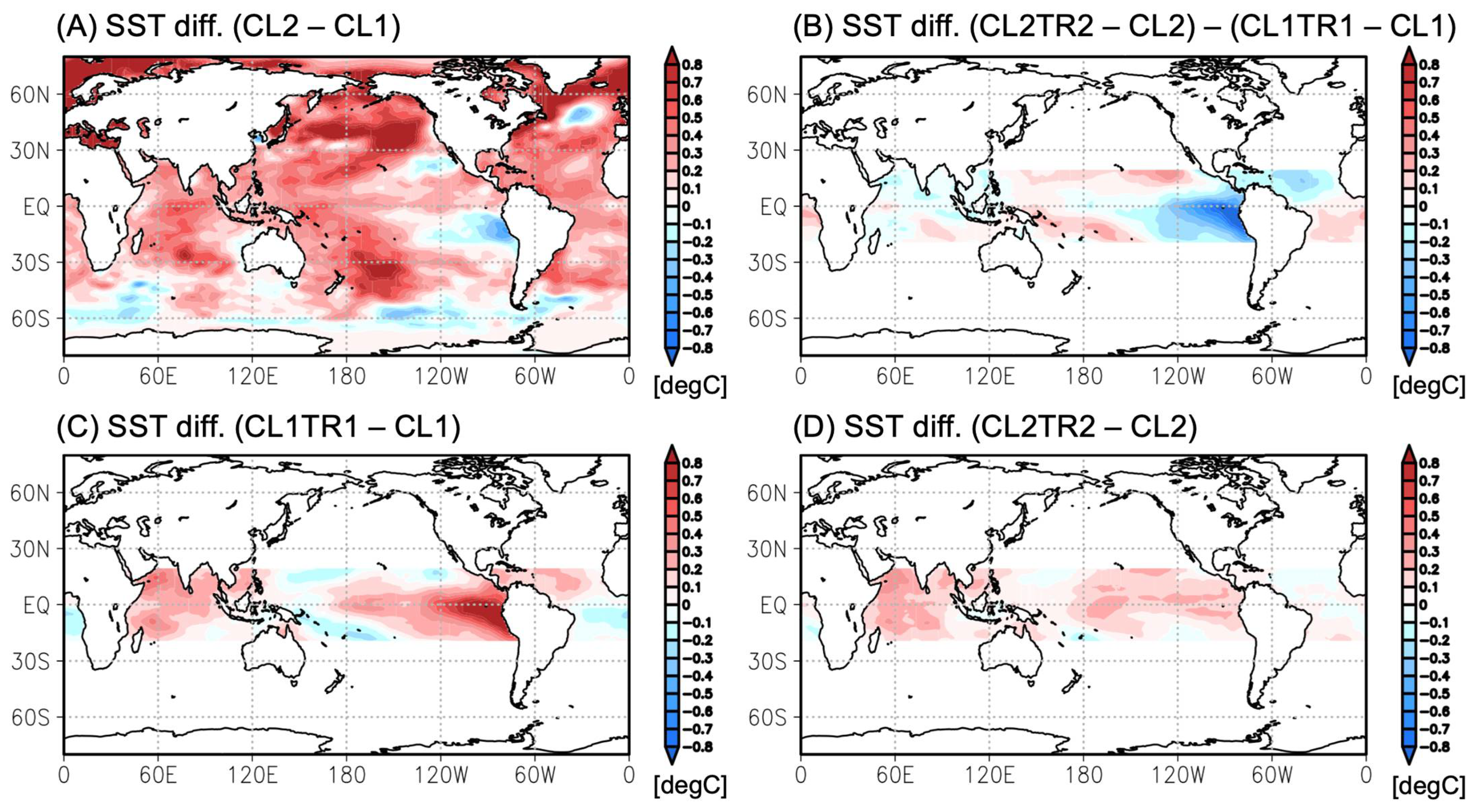
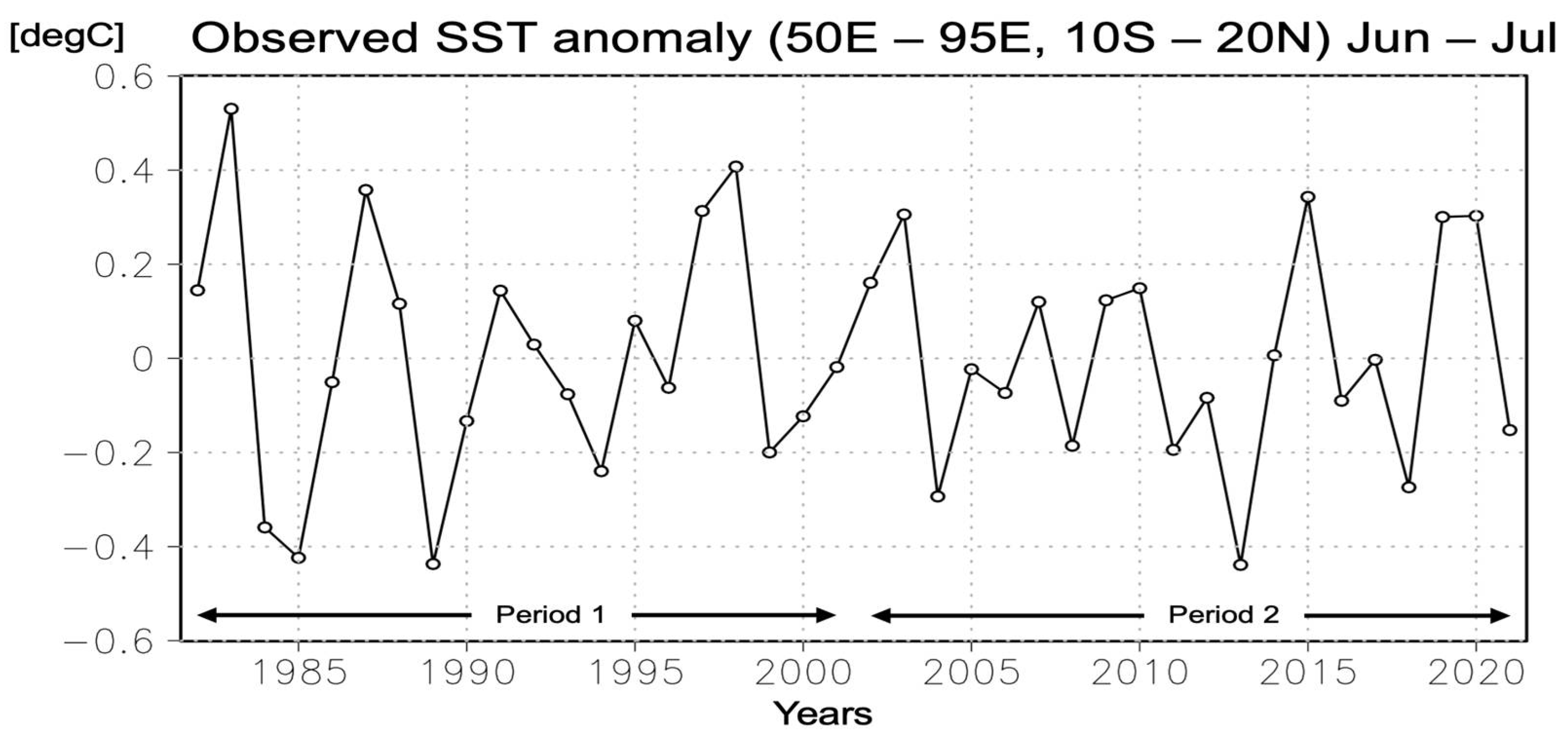

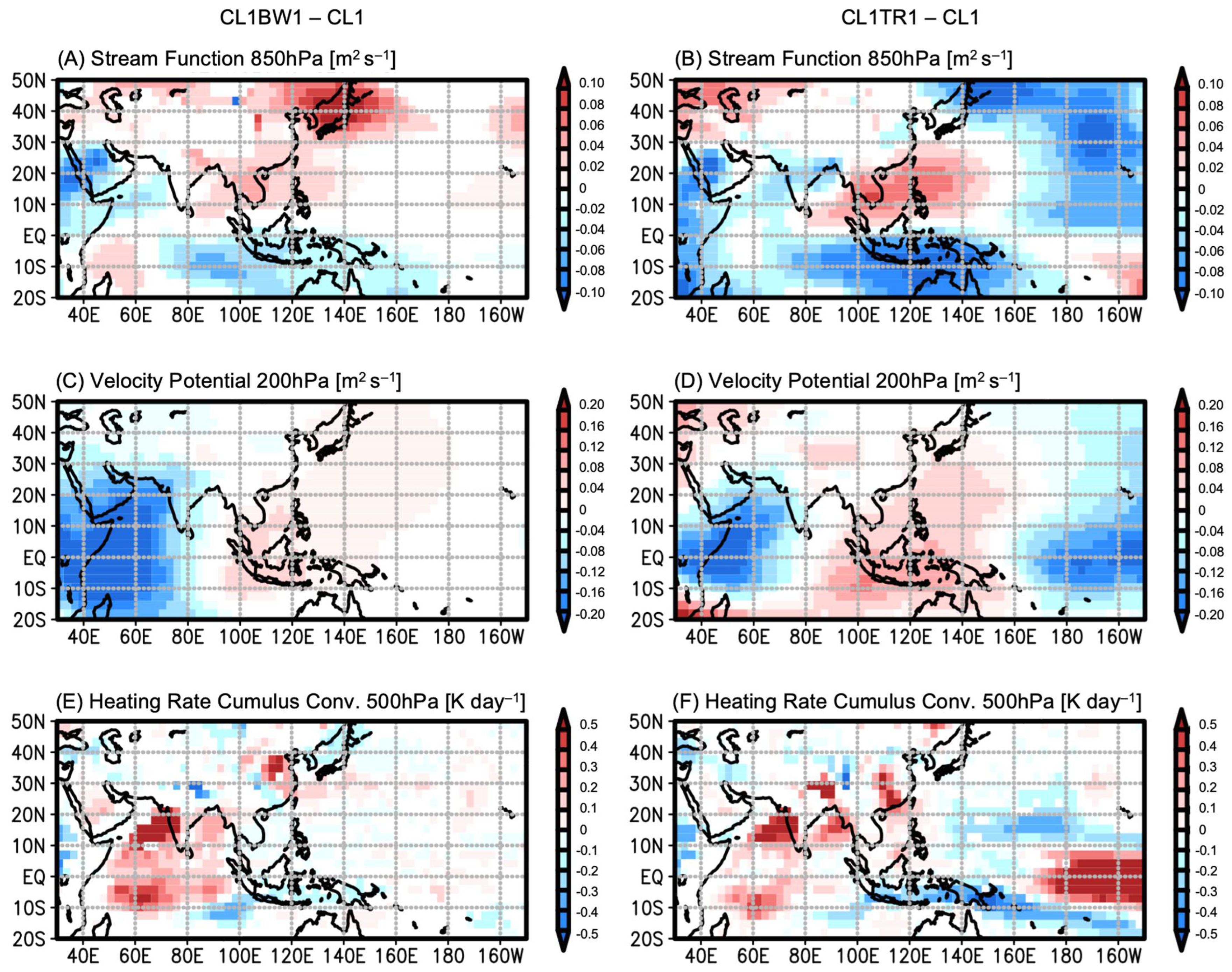



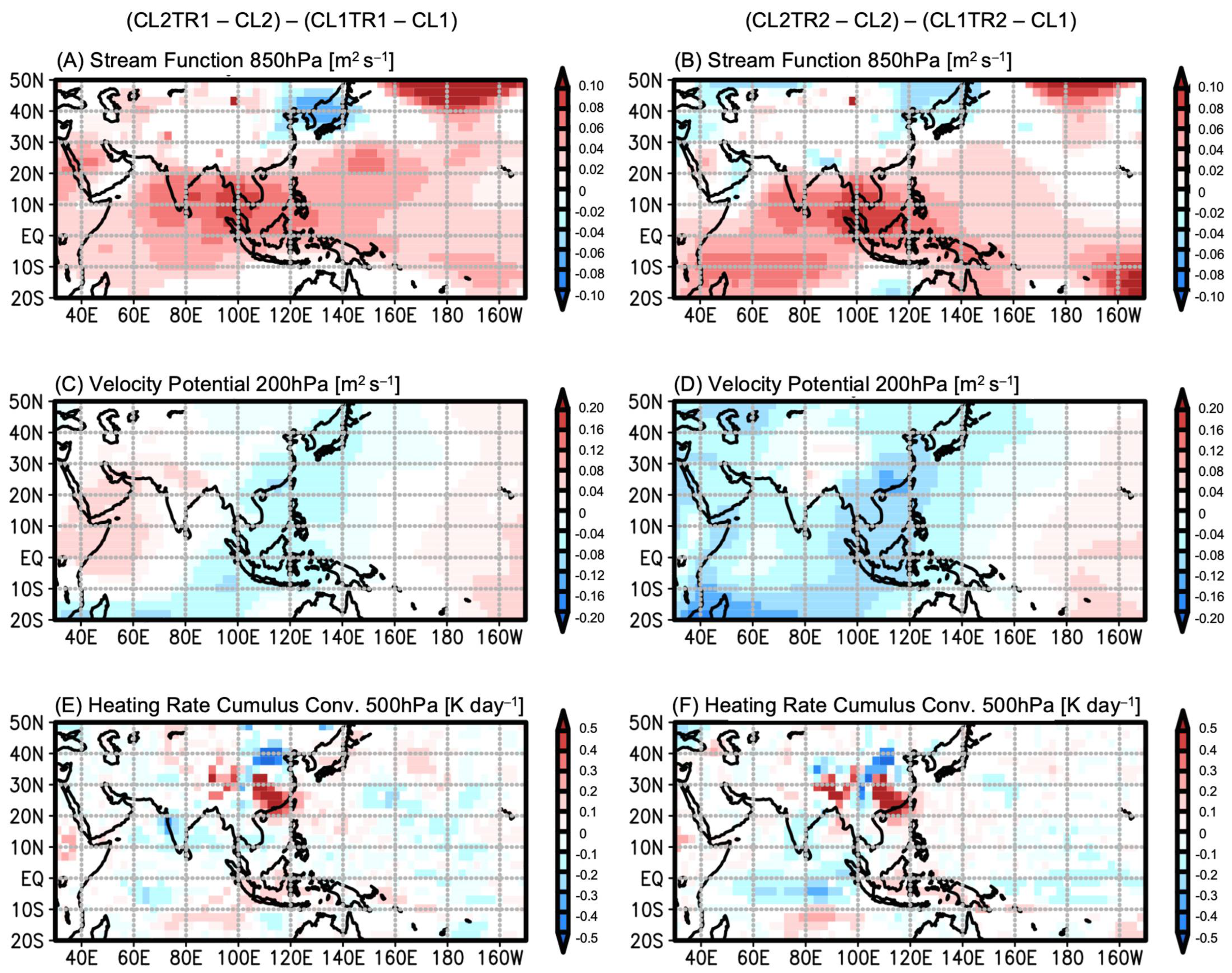
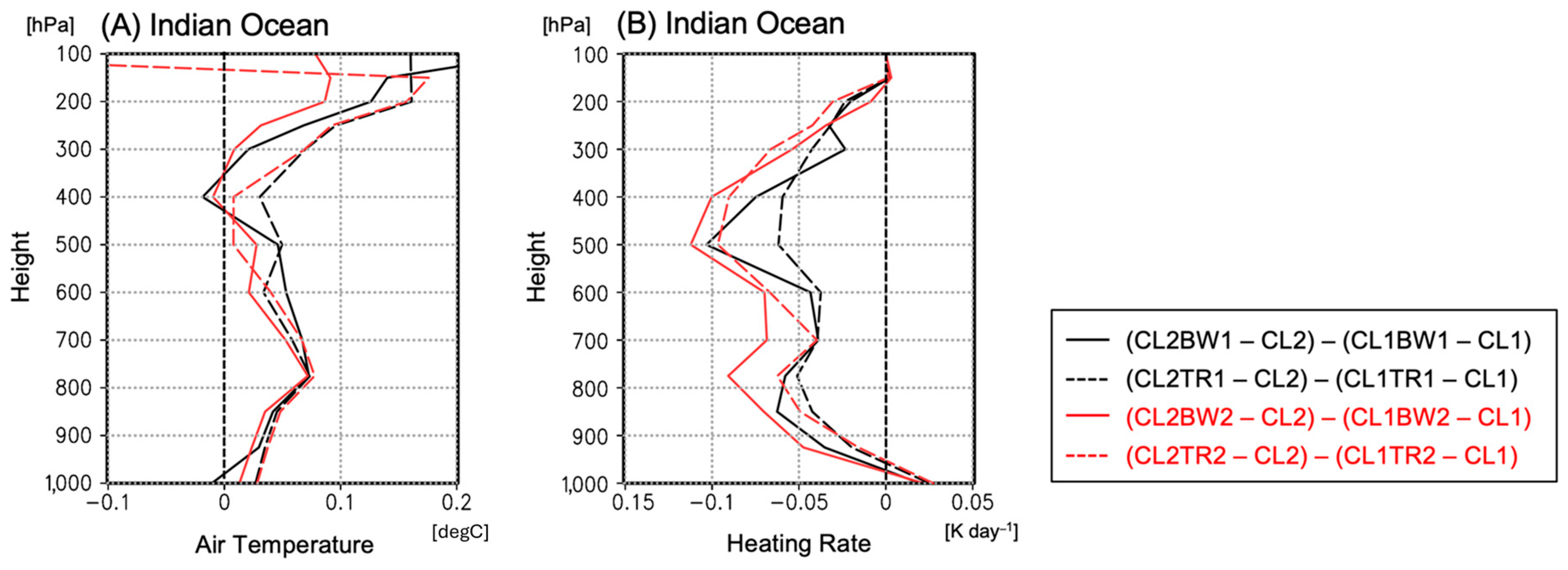
| Name of Simulation | SST Climatology | SST Anomaly |
|---|---|---|
| CL1 | Period 1 | None |
| CL1BW1 | Period 1 | Indian Ocean in Period 1 |
| CL1TR1 | Period 1 | Tropical Oceans in Period 1 |
| CL2 | Period 2 | None |
| CL2BW2 | Period 2 | Indian Ocean in Period 2 |
| CL2TR2 | Period 2 | Tropical Oceans in Period 2 |
| CL1BW2 | Period 1 | Indian Ocean in Period 2 |
| CL1TR2 | Period 1 | Tropical Ocean in Period 2 |
| CL2BW1 | Period 2 | Indian Ocean in Period 1 |
| CL2TR1 | Period 2 | Tropical Ocean in Period 1 |
Disclaimer/Publisher’s Note: The statements, opinions and data contained in all publications are solely those of the individual author(s) and contributor(s) and not of MDPI and/or the editor(s). MDPI and/or the editor(s) disclaim responsibility for any injury to people or property resulting from any ideas, methods, instructions or products referred to in the content. |
© 2025 by the authors. Licensee MDPI, Basel, Switzerland. This article is an open access article distributed under the terms and conditions of the Creative Commons Attribution (CC BY) license (https://creativecommons.org/licenses/by/4.0/).
Share and Cite
Mochizuki, T.; Ando, Y. Decadal Modulation of Summertime Northwestern Pacific Subtropical High Linked to Indian Ocean Basin Warming. Climate 2025, 13, 106. https://doi.org/10.3390/cli13060106
Mochizuki T, Ando Y. Decadal Modulation of Summertime Northwestern Pacific Subtropical High Linked to Indian Ocean Basin Warming. Climate. 2025; 13(6):106. https://doi.org/10.3390/cli13060106
Chicago/Turabian StyleMochizuki, Takashi, and Yuta Ando. 2025. "Decadal Modulation of Summertime Northwestern Pacific Subtropical High Linked to Indian Ocean Basin Warming" Climate 13, no. 6: 106. https://doi.org/10.3390/cli13060106
APA StyleMochizuki, T., & Ando, Y. (2025). Decadal Modulation of Summertime Northwestern Pacific Subtropical High Linked to Indian Ocean Basin Warming. Climate, 13(6), 106. https://doi.org/10.3390/cli13060106






